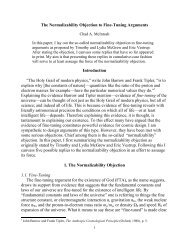Theism and Explanation - Appeared-to-Blogly
Theism and Explanation - Appeared-to-Blogly
Theism and Explanation - Appeared-to-Blogly
You also want an ePaper? Increase the reach of your titles
YUMPU automatically turns print PDFs into web optimized ePapers that Google loves.
170 Notes<br />
82. Lip<strong>to</strong>n, Inference <strong>to</strong> Best <strong>Explanation</strong>, 24. The same argument, as it happens,<br />
is put in<strong>to</strong> the mouth of Cleanthes in David Hume’s “Dialogues” (iv<br />
[65]; see Mackie, Miracle of <strong>Theism</strong>, 143).<br />
83. Draper, “God, Science, <strong>and</strong> Naturalism,” 297–98.<br />
84. Ibid., 297.<br />
NOTES TO CHAPTER 2<br />
1. Swinburne, Existence of God, 7.<br />
2. Rowe, Can God Be Free?, 1.<br />
3. Boyer, Naturalness of Religious Ideas, 43.<br />
4. Barrett <strong>and</strong> Keil, “Conceptualizing a Nonnatural Entity,” 240.<br />
5. I have argued elsewhere (“What is Wrong with Intelligent Design?” 79–80)<br />
that “intelligent design theory” also falls short of being a theory, since it is<br />
far from clear what would follow, if its vague claim of “design” were true. If<br />
any quasi-religious explanation merits Darwin’s criticism (1.3.2), it is surely<br />
this one.<br />
6. Meyer is currently the programme direc<strong>to</strong>r of the Center for Science <strong>and</strong> Culture<br />
at the Discovery Institute in Seattle, the headquarters of the ID movement.<br />
In an admirably upfront manner, Meyer (“The Return of the God<br />
Hypothesis,” 27) argues that theism can be supported by way of “inference<br />
<strong>to</strong> the best explanation” (IBE). “<strong>Theism</strong>,” he writes, “explains a wide ensemble<br />
of metaphysically-signifi cant scientifi c evidences <strong>and</strong> theoretical results<br />
more simply, adequately, <strong>and</strong> comprehensively than other major competing<br />
world views or metaphysical systems.”<br />
7. For another example, see Behe, Darwin’s Black Box, 232–53.<br />
8. Or, perhaps, “theistic proposed explanation,” if that were not so awkward a<br />
phrase.<br />
9. I have borrowed this phrase from Peter Lip<strong>to</strong>n (Inference <strong>to</strong> Best <strong>Explanation</strong>,<br />
59–60).<br />
10. Peirce, Collected Papers, 5:117 (§189). Actually, Peirce offered a number of<br />
analyses of what he also called “hypothesis” or “retroduction” (Niiniluo<strong>to</strong>,<br />
“Truth-seeking by Abduction,” 57–64), but this is the form upon which he<br />
fi nally settled.<br />
11. Here, as in some other key respects, my account of explanation follows that<br />
of Carl Hempel (see, for instance, his Aspects of Scientifi c <strong>Explanation</strong>,<br />
338), even though the explanations with which I am dealing do not have<br />
exactly the same form as the deductive-nomological explanations that he<br />
championed.<br />
12. Lip<strong>to</strong>n, Inference <strong>to</strong> Best <strong>Explanation</strong>, 60.<br />
13. Psillos, Causation <strong>and</strong> <strong>Explanation</strong>, 97.<br />
14. Perhaps Lip<strong>to</strong>n is thinking of causal overdetermination (see 4.3.3.1) rather<br />
than preemption. An example would be the situation in which two assassins<br />
fi re simultaneously <strong>and</strong> infl ict what would be, even taken individually,<br />
fatal wounds. But I fail <strong>to</strong> see how this would count against my distinction,<br />
although it may count against the idea that a cause must be a necessary condition<br />
of its effect.<br />
15. National Academy of Sciences, Science <strong>and</strong> Creationism, 2.<br />
16. Ibid.<br />
17. See, for instance, Collins, “God, Design, <strong>and</strong> Fine-Tuning,” 123. I shall discuss<br />
Swinburne’s work in some detail later (6.1.2).<br />
18. For the thought behind this defi nition, I am indebted <strong>to</strong> Alan Musgrave<br />
(“Deductivism,” 19), although I have reformulated it in the light of my later<br />
discussion (2.1.3.2 <strong>and</strong> 3.1.2).



